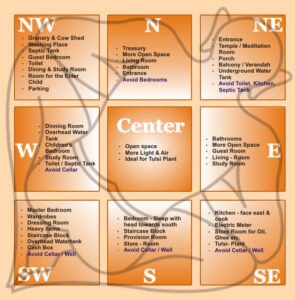Vastu Shastra is an ancient mystic science of designing and building that unites art, astronomy and architecture. The Sanskrit word ‘Vastu’ means a dwelling or a building used for residential purpose. It is a complete understanding of direction, geography, topography, environment and physics.
The aim of Vastu Shastra is to establish a dynamic balance between form and energy, to create a harmonious environment for the inhabitants. Therefore, they promote stability, happiness, prosperity and peace for the occupants of owners. Various energies, like solar, lunar, Earth, sky, etc are used for bring in the positive energy.
Vastu Shastra is the Vedic Science of Architecture. It is the study that dictates the form, size and orientation of a building, in relation to the plot, soil, surroundings and the personality of the owner/dweller.
There are 5 Fundamental Principles upon which the Vedic Science of architecture stands on:
- The Doctrine of Orientation
In Vastu, the east and north direction are very important. As the sun rises in the east, the rich in vitamin D sun rays are welcomed into the house by placing most of the door and windows in that direction. On the other hand, as the sun emits infrared rays, less windows are preferred over the southwest direction, with thick walls. Moreover, as the magnetic fields have a significant impact on the well being of the residents. Vastu recommends the inmates of the house to sleep with their heads on the south side as the magnetic field of earth can effect the blood circulation of the body.
- Site Planning : Vastu Purush Mandala

 Vastu means environment, Purush means energy, and Mandala refers to the astrological chart which relates to layout and orientation. Vastu Purusha Mandala, is a metaphysical square plan that illustrates how the Vastu Purusha was pinned down by Brahma and 44 Gods – face down, with his head to the North-East and his feet towards the South-West.
Vastu means environment, Purush means energy, and Mandala refers to the astrological chart which relates to layout and orientation. Vastu Purusha Mandala, is a metaphysical square plan that illustrates how the Vastu Purusha was pinned down by Brahma and 44 Gods – face down, with his head to the North-East and his feet towards the South-West.
The diagram is divided in 9×9=81 parts, showing how Brahma and the 44 gods are holding down the Vastu Purusha. Therefore, these symbolic gods rule the various aspects of life and have certain inherent qualities.For Example, there should not be anytime of heavy structure in the centre, as it is ruled by Brahma, the supreme one. This space should allow natural ventilation and free flow of air. Also, the various placement of rooms is determined by the deity ruling them. -
The Proportionate Measurement : Maana
The Vastu principle ‘Maana-Proportions’ prescribes the perfect ratio of height-to-breadth of a anything, to make it look proportionate. After trial and error, ancient Indian Pundits came to perfect measurements ratio of height, length and breadth- to create a proportionate three dimensional building.
Vastu Shastra prescribes proportionate ratios of the hieght, breadth, width, plumb lines, thickness and interspace, in order to create buildings with good proportions. -
Dimensions of the Building- Aayadi
Eventhough, the science of Vastu follows a set of generic rules, a specific set of six formulae called Aayadiare used to work out the Length, Breadth, perimeter, area and the height of the building.
Aayadi constitutes six formulae Aaya, Vyaya, Yoni, Raksha, Vara and Tithi. The remainder obtained by using these formulae determines whether it is a gain or loss. If it is a gain, then the structure is proportionate and stable and the dimensions are right. However if it is a loss, then it means the dimensions are not right and should be suitably corrected. -
Aesthetics of the building- Chanda
Chanda means beauty. Chanda refers to a view of the contour of a structure against the sky, i.e. its perspective view. The contour of different buildings varied according to the functions.
According to Vastu Shasta, following the principle of Chanda would ensure the building is pleasing to the eye. Also, it adheres to the different functions it caters, and provide an easy identification of buildiings. For example, a temple can easily be identified by it’s mountain like form.
In this article, we have briefly discussed the 5 Princples of Vastu Shastra, but these principles. Vastu Shastra has a huge impact on our physical and mental health of our body. It influences the quality of life of the users.



